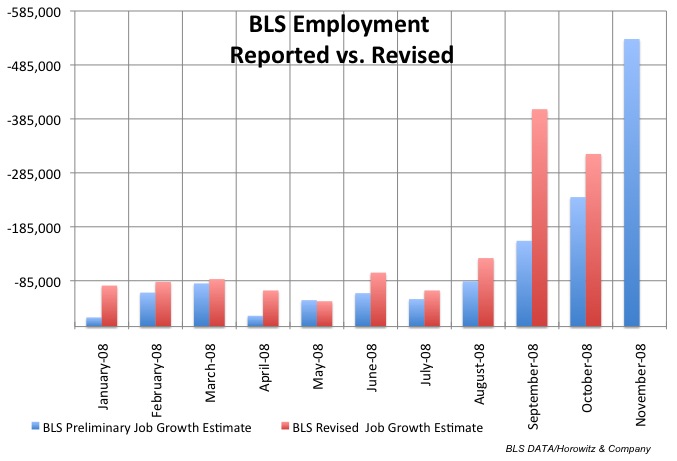It is reported that the U.S. unemployment rate for November rose to a recent high of 6.7% of the population. The same report showed non-farm payrolls fell by 533,000… at least that is what the headline will initially lead us to believe. But taking a closer look into this report reveals a much more concerning trend of downward revisions and questionable accounting with many of the respondent components.
Last week we posted a projection of what to look for in the coming release and specifically pointed out that revisions to previous reports could be nasty as there is a regular time lag of the survey responses.
From the BLS release:
Nonfarm payroll employment fell sharply (-533,000) in November, and the unemployment rate rose from 6.5 to 6.7 percent, the Bureau of Labor Statistics of the U.S. Department of Labor reported today. November’s drop in payroll employment followed declines of 403,000 in September and 320,000 in October, as revised. Job losses were large and widespread across the major industry sectors in November.
Our friends at Trim Tabs (Scheduled TDI Podcast guest ) have continued to challenge the BLS and their methodology as they have found several flaws and broad inaccuracies in that:
- Changes in employment in the service sector are not fully captured.
- Heavy seasonal adjustments often obscure trends in employment.
- Employment growth at smaller companies and growth in self-employment are not fully captured.
- The company””birth/death“adjustments are nothing more than educated guesses.
- Only 60% of the survey for the latest month is complete.
Digging even deeper, the recent BLS report shows a massive decrease in the September employment figures. In fact, September was revised downward by 153% and October by 33%:
The change in total nonfarm employment for September was revised from -284,000 to -403,000, and the change for October was revised from -159,000 to -320,000. In both months, there were large revisions in most of the major industry sectors. These revisions resulted primarily because of the normal monthly recalculation of seasonal factors rather than the incorporation of additional sample reports.
Now for the real problem: If the reporting period ends on the 16th of the month, jobs losses are assumed to be accelerating and revisions have been substantial, can we assume that the latest release is light as well?
Even assuming a smaller than usual revision of 25% , the actual number could really be closer to 650,000 once revised and rising…

















